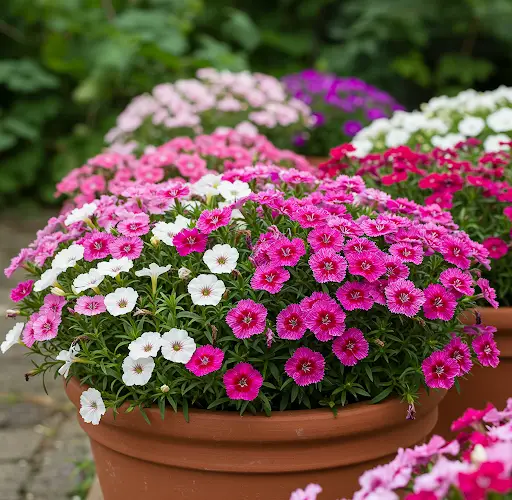Clarkia, also known as Godetia or farewell-to-spring, is an elegant and easy-to-grow annual flower that brings a burst of color to any garden. Native to western North America, Clarkia thrives in cool weather and is especially appreciated for its delicate, crepe-paper-like blooms in shades of pink, lavender, coral, and white. Whether grown in garden beds, borders, or containers, Clarkia is a rewarding flower that performs well with minimal care.
If you’re looking for a low-maintenance, beginner-friendly flower to brighten your outdoor space, Clarkia is an excellent choice. This guide will walk you through the steps of growing Clarkia from seed—no green thumb required.
Why Choose Clarkia?
Clarkia offers several advantages for home gardeners:
-
Easy to grow from seed—no need for transplants.
-
Beautiful cut flowers—long-lasting and elegant in floral arrangements.
-
Pollinator-friendly—attracts bees and butterflies.
-
Great for containers or small spaces.
-
Cool-season annual—ideal for spring and fall displays.
With its soft pastel blooms and graceful, upright stems, Clarkia adds cottage-garden charm wherever it’s planted.
When to Sow Clarkia Seeds
Clarkia thrives in cooler temperatures, so timing is key for successful growth. Depending on your climate:
-
In mild winter regions (zones 8–10): Sow seeds in late fall to early winter for spring blooms.
-
In cooler climates (zones 3–7): Sow seeds in early spring, as soon as the soil can be worked. Alternatively, you can start seeds indoors 4–6 weeks before the last frost and transplant carefully.
Clarkia doesn’t transplant well due to its delicate root system, so direct sowing is preferred whenever possible.
What You’ll Need
-
Clarkia (Godetia) seeds
-
Garden bed or containers with drainage
-
Fine, well-draining soil
-
Trowel or rake
-
Watering can or hose with a gentle spray
-
Mulch (optional)
Step 1: Choose a Location
Select a planting site that receives full sun to light shade. Clarkia performs best with at least 6 hours of sunlight per day. It prefers cooler conditions and may struggle in intense summer heat, so afternoon shade is beneficial in hotter climates.
Clarkia tolerates a range of soils but does best in well-draining, moderately fertile soil. Avoid overly rich soil, which can lead to excess foliage at the expense of blooms.
Step 2: Prepare the Soil or Container
If sowing in a garden bed, loosen the soil to a depth of about 6 inches and remove any weeds or debris. Rake the surface smooth and lightly moisten it.
For containers, choose pots at least 8–10 inches deep with drainage holes. Use a lightweight potting mix with added compost or perlite for aeration. Avoid compacted or heavy soils, as Clarkia roots are shallow and fine.
Step 3: Sow the Seeds
Scatter the seeds thinly over the surface of the soil. Press them lightly into the soil or cover with a very thin layer—Clarkia seeds need light to germinate, so avoid burying them too deeply.
Water gently with a fine spray. Keep the soil consistently moist but not soggy during the germination period, which usually takes 7–14 days.
For a longer bloom period, succession sow every 2–3 weeks during the cool season.
Step 4: Thin the Seedlings
Once seedlings are 2–3 inches tall, thin them to about 6 inches apart. This gives each plant enough space to grow and allows air to circulate, which helps prevent mildew or fungal issues.
The thinned seedlings can be gently transplanted if needed, but be very careful not to disturb the roots.
Step 5: Watering and Maintenance
Clarkia prefers even moisture but doesn’t like wet feet. Water regularly, especially during dry spells, but let the soil surface dry slightly between watering.
You can add a light layer of mulch to conserve moisture and keep weeds down.
Clarkia generally doesn’t need much fertilizing. Too much nitrogen will promote foliage at the expense of flowers. If desired, apply a balanced organic fertilizer once when plants are 4–6 inches tall.
Step 6: Support and Bloom Care
Some taller Clarkia varieties benefit from light staking or plant supports to prevent flopping, especially in windy areas.
Once the plants begin to bloom (about 8–10 weeks from sowing), enjoy the colorful display. Deadheading (removing spent flowers) can extend the blooming period, though Clarkia will often self-sow if left to go to seed.
Step 7: Harvesting and Saving Seeds
Clarkia makes a beautiful cut flower. Harvest stems when half the buds are open and place them in water immediately. They can last up to a week in a vase.
If you want to save seeds, allow a few flower heads to dry on the plant. Once dry and brown, clip them and shake out the small seeds. Store them in a cool, dry place for the next season.
Final Tips for Success
-
Clarkia performs best in temperatures between 50–70°F (10–21°C).
-
Protect young seedlings from slugs and snails.
-
Avoid overhead watering once flowers appear to reduce mildew risk.
-
Don’t overfertilize—Clarkia thrives on minimal feeding.
With its graceful blooms and ease of care, Clarkia is a fantastic addition to any home garden. Whether you’re growing it in containers or garden beds, this cheerful annual flower brings soft color and gentle beauty through the cool seasons.



